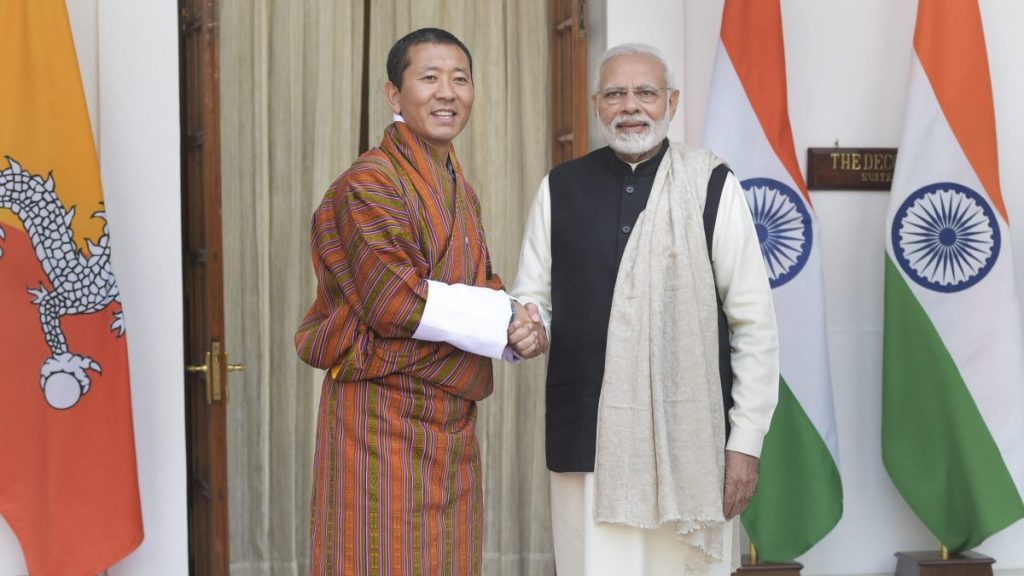In relations between the two countries, economy, security and strategy—are often seen as corner stones of bilateral engagement. Bhutan, a tiniest South Asian nation with a few million people, is one of the closest neighbours of India. Nestled in the Himalaya, Bhutan has a very high strategic worth for India and this is the reason why China which has no diplomatic relations with Thimpu, wants to win it over. In 2017, by creating a commotion militarily over Doklam, a plateau lying at an India, Bhutan and China tri-junction, Beijing tried to apply pressure on Bhutan, but it summarily failed as PLA Army, despite 73-day standoff with Indian Army, could not demolish the latter created impregnable bulwark around the area. This incident further cemented bond between New Delhi and Thimpu. But over the years, especially after the arrival of democracy in the Himalayan nation in 2008, Bhutan has tried to give wings to its ambition-both at diplomatic and economic fronts.
This has left India to deal cautiously with Bhutan, which has hinted of diversifying its economy in order to rely less on New Delhi for funds to run its day, today affairs. India’s allocation of Rs 4500 crore to Bhutan under its 12th Five Year Plan, indicates categorically about the Himalayan nation’s desire to use the fund for various projects. India has also committed to fund Rs 400 crore to Bhutan under a transitional trade support facility over a period of five years to strengthen bilateral trade and economic linkages. Under the 11th Five Year Plan too, Bhutan had received Rs 4500 crore although it had also received Rs 500 crore under its Economic Stimulus Plan. This is apart from other financial assistance offered from time to time to Bhutan by India, which is involved in several infrastructural and capacity building projects in the Himalayan nation. However, behind every Indian move towards Bhutan, there is one implicit strategy: Strengthen the bond of friendship with Thimpu. This was once again on display when the country’s elected Prime Minister Dr Lotay Tshering undertook his maiden three-day state visit to India from December 27.
“The visit coincides with the Golden Jubilee year of the establishment of formal diplomatic relations between Bhutan and India,” the Ministry of Foreign Affairs of Royal Government of Bhutan said in statement. This prime ministerial visit took place close on the heels of newly elected Maldivian President Ibrahim Mohamed Solih’s three-day visit to India in the third week of December. Like Maldives, Bhutan too has ‘India First’ as its policy. At the time when New Delhi and Thimpu are celebrating 50 years of their diplomatic engagement, both countries tried to build on vision expressed by Prime Minister Narendra Modi during his visit to Bhutan in 2014. “Bharat should stand for Bhutan and Bhutan for India,” Prime Minister Modi had said.
The Bhutan Prime Minister discussed various aspects of bilateral relations, including Bhutan’s 12th Five Year Plan and hydropower cooperation with Indian leaders during his three-day visit. Under the 11th Five Year Plan, India had committed Rs 4500 crore to Bhutan. Of this total, Rs 2800 crore was provided as Project Ties Assistance(PTA), Rs 850 crore for Small Development Projects(SDP) and Rs 850 crore as Programme Grant/ Development Subsidies. India had also offered Rs 500 crore for the Economic Stimulus Plan of Bhutan.
Cooperation in hydropower sector was another major agenda of the talks between the two sides during the Bhutan Prime Minister’s visit. Under their energy partnership, New Delhi and Thimpu are engaged in building several hydropower projects. During Tshering’s visit, the two countries discussed tariff rates for the 720-MW Mangdechhu hydropower project. Built with Indian assistance, the hydropower project in Bhutan is about to see commissioning soon. It is run-of-the river project located on river Mangdechhu in Trongsa Dzongkhag district of Central Bhutan.
Under the 2006 energy pact, India agreed to assist Bhutan in developing a minimum of 10,000 MW of hydropower and import the surplus electricity from this to India by 2020. So far India has constructed three hydropower projects in the Himalayan country—336 MW Chukha project, 60MW Kurichhu project and 1020 MW Tala project. All these three are operational and exporting surplus electricity to India.
In keeping with the 2007 India-Bhutan Friendship Treaty, the two countries have agreed to cooperate closely with each other on issues of their national interests. Not only India is responsible for the protection of Bhutan from all kinds of external threat, it is also responsible to offer the tiny Himalayan country financial and other necessary humanitarian assistance. Trust and mutual understanding developed between the two countries over the years got further strengthened during Prime Minister Tshering’s visit. Chinese leaders must be scratching their heads for ways to engage with Bhutan, but it can’t happen so long as India stands in its way. Already, New Delhi has made it clear to Beijing that Bhutan is not Nepal where, despite enjoying well entrenched political, economic, cultural, ethnic and people-to-people relationship with India, China has emerged as a powerful influential factor. For this, thanks goes to incumbent Nepal government which is headed by K P Oli, a communist whose ideological leanings find China closer than India, a democratic republic.


















